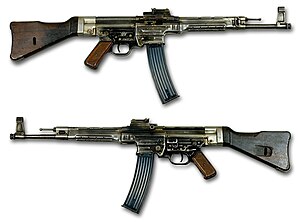
Back StG 44 Afrikaans بندقية هجومية 44 (StG44) Arabic StG 44 Azerbaijani StG-44 Byelorussian StG-44 BE-X-OLD StG44 Bulgarian Sturmgewehr 44 Breton StG 44 BS StG 44 Catalan StG 44 Czech
| Sturmgewehr 44 | |
|---|---|
 MP 44 (StG 44) from the collections of the Swedish Army Museum | |
| Type | Assault rifle |
| Place of origin | Germany |
| Service history | |
| In service |
|
| Used by | See Users |
| Wars | |
| Production history | |
| Designer | Hugo Schmeisser |
| Designed | 1938–1943 |
| Manufacturer | |
| Unit cost |
|
| Produced | 1943–1945 |
| No. built | 425,977 |
| Variants | MKb 42(H), MKb 42(W), MP 43, MP 43/1, MP 44 |
| Specifications | |
| Mass | |
| Length | 94 cm (37 in) |
| Barrel length | 42 cm (16.5 in) |
| Cartridge | 7.92×33mm Kurz[3] |
| Action | Gas-operated long-stroke piston, closed tilting bolt, selective fire |
| Rate of fire | ~500-600 rounds/min |
| Muzzle velocity | 685 m/s (2,247 ft/s) |
| Effective firing range |
|
| Feed system | 30-round detachable box magazine |
| Sights | Adjustable sights, rear: V-notch; front: hooded post |
The StG 44 (abbreviation of Sturmgewehr 44, "assault rifle 44") is a German assault rifle developed during World War II by Hugo Schmeisser. It is also known by its early designations as the MP 43 and MP 44 (Maschinenpistole 43 and 44). The StG 44 was an improvement of an earlier design, the Maschinenkarabiner 42(H).
The StG 44 was the first successful assault rifle, with features including an intermediate cartridge, controllable automatic fire, a more compact design than a battle rifle with a higher rate of fire, and being designed primarily for hitting targets within a few hundred metres.[5] Other rifles at the time were designed to hit targets at greater ranges, but this was found to be in excess of the range in which most enemy engagements actually took place.
The StG 44 fulfilled its role effectively, particularly on the Eastern Front, offering a greatly increased volume of fire compared to standard infantry rifles. The StG largely influenced the Soviet AK-47, introduced two years after the war concluded.[5][6] The StG's influence can still be seen in modern assault rifles, which, after World War II, became the global standard for infantry rifles.[5]
- ^ Sturmgewehr 44 (StG44) D1854/3 Manual
- ^ The full weight of the StG 44 with empty magazine and sling is 4.62 kg according to the original Sturmgewehr 44 (StG44) D1854/3 Manual, and each 7.92mm S.m.E. Kurz round weighs in at 17.05 grams a piece according to the original 7.92 Kurz Polte drawings, so with 30 rounds in the magazine the fully loaded weight of the StG 44 will be 5.13 kg.
- ^ Hogg, Ian V. & Gander, Terry (2005). Jane's Guns Recognition Guide (4th ed.). Glasgow: HarperCollins. p. 287. ISBN 978-0-00718-328-9.
- ^ Rusiecki, Stephen M. (2010). In Final Defense of the Reich: The Destruction of the 6th SS Mountain Division "Nord". Annapolis, MD: Naval Institute Press. p. 361. ISBN 978-1-59114-744-2.
- ^ a b c Hogg, Ian V. & Gander, Terry (2005). Jane's Guns Recognition Guide (4th ed.). Glasgow: HarperCollins. p. 287. ISBN 978-0-00718-328-9.
This is the father of all assault rifles, developed in Germany in 1941–42 and using a new short cartridge. Originally known as the MP 43 (Machine Pistol) for Nazi political reasons, it was renamed the "Sturmgewehr 44" after its successful introduction into battle on the Eastern Front. It introduced the concept of using a short cartridge with limited range in order to permit controllable automatic fire and a compact weapon, and because experience showed that most rifle fire was conducted at ranges under 400 meters. After the war it was examined and dissected by almost every major gunmaking nation and led, in one way and another, to the present-day 5.56mm assault rifles.
- ^ McNab, Chris (2013). German Automatic Rifles 1941-1945: Gew 41, Gew 43, FG 42, StG 44. Oxford, UK: Osprey Publishing. pp. 67–72. ISBN 978-1-78096-385-3.
© MMXXIII Rich X Search. We shall prevail. All rights reserved. Rich X Search